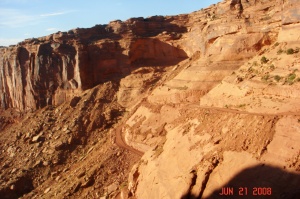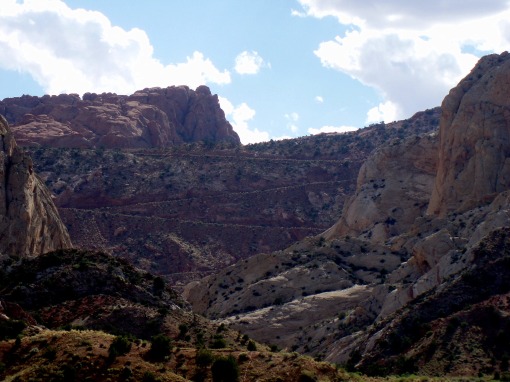| |
| I shall be telling this with a sigh |
|
| Somewhere ages and ages hence: |
|
| Two roads diverged in a wood, and I— |
|
| I took the one less traveled by, |
|
| And that has made all the difference. |
(last stanza of Robert Frost’s Road Not Taken)
As I desperately tried not to look down the steep, Aspen dense slope that dropped off abruptly to the car’s left as we crawled over rocks and sunk into ditches on our latest road-less-travelled escapade (unwittingly done in my Subaru forester with tread-worn tires, but that’s a story for later in the blog), I began to recognize the situation as oddly familiar. In fact, I could recall three other recent occasions that had sent me edging across the passenger seat trying to get as close to the center console as possible while still being able to grip the door handle with enough force to turn my knuckles white. As I sat with my eyes pinched shut and focused on taking deep breathes, I began to wonder: why do I keep ending up in these situations?
And so I began to recall the harrowing dirt and gravel roads I have found myself on four fear-instilling times since March. Each time I ended up on a road less traveled, I decided that these roads are less traveled because most people choose to stick to less exposed, safer feeling routes of travel. Don’t get me wrong, each road has afforded views that the standard road can’t get close to. However, each has also included dizzying switchbacks alongside plunging drop-offs. Of course, there are no guard rails either. I’ve been told that guard rails provide people with a false sense of security on such roads. Well after driving and/or riding up and down the following four scenic and sketchy roads, I’d take any feeling of security – false or not. So without further ado, here are the roads in chronological order: The Moki Dugway, Mineral Bottom road to the Labrynith Canyon take-out, the Burr Trail, and the 4×4 off-chute of the Mt. Bachelor mining tour loop.
The Moki Dugway:a grated, steep, switchbacked road in Cedar Mesa that winds its way to the top of a mesa known to have spectacular Anazasi ruins and petroglyphs hidden in its many canyons
(No pictures of the road are available because I didn’t know it would be one of four-part series of hair-raising events. However, you can check out the handful of pictures from this trip and others to Cedar Mesa on Picasa.
Had I known what was in store on the other 3 roads described here, this road probably wouldn’t have made my fear-instilling list. But at the time – without the comparisons to come – it was unnerving. If I drive up it again it would probably make me uneasy; but the very fact that I am willing to go up it again in the driver’s seat puts it in a different category from the others.
Mineral Bottom Road: steep dirt road plunging from Dead Horse Mesa ‘s edge down 900 feet to the Colorado River’s bank; it is a constantly switch-backing road with exposure to sheer canyon cliffs dropping to/rising from the CO river always at your side

- View of Mineral Bottom Road
[Note: these pictures were taken by my sister-in-law on our way up Mineral Bottom after the Labrynith Canyon river trip (hence the rafts being towed by the Jeep). Since we were “just running a shuttle” on the way down, I hadn’t thought about taking my camera … not that I would have had steady enough hands to use it then anyway.]
My husband did not forewarn me of the road to come. However, I later found out that when we turned west off SR 313, he had told my father “we’re going to drive down a dirt long for a long time and then drop off the edge of the earth.” Perhaps it’s best that he hadn’t prepared me because his description of Mineral Bottom road was exactly right. I found myself in the driver’s seat going down Mineral Bottom road as the sun was producing one strong, blinding glow of daylight before it slipped behind the canyon walls, driving my father-in-law’s relatively new Rav 4. My father from WV was behind me in my sister-in-law’s Subaru; driving stick for the first time in years. Then there was my husband blazing down the switchbacks in his Jeep, sitting on his roll bars while taking the occasional break to wait for us catch-up. It was slow-going at 5 miles an hour or less. There were times I had to stop the car to calm my breathing before I could ease my foot off the breaks a bit and inch around yet another terrifying turn. There were tears, there was anger, but mostly a sense of panic and an strong wish that the whole situation would just go away. In the end, I made it through and happily conceded the driver’s seat to my husband for the drive up (the Jeep and Subaru were left at the river’s take-out, as we were running a shuttle). I must say, on Mineral Bottom Road going up is far better than going down.
A google search of “Mineral Bottom Road” produced this Youtube video of a drive down it.
The Burr Trail: this grated dirt road is a turn off of another dirt road miles from any sign of civilization; it winds its way up and over Capital Reef National Park in a series of exposed switchbacks before winding its way into the Escalante Grand Staircase and dead-ending into Rt.12 at Boulder, UT

- Burr Trail Switchbacks
As the locale should indicate, this road travels through an awe-inspiring landscapes that are on scale to massive to capture with a camera. Of course, I tried. When compared to Mineral Bottom road or the 4×4 Mt. Bachelor off-chute, this road is not nearly as terrifying. Though I would not care to take the driver’s seat and never want to drive or ride down the switchbacks we went up, I could sit shot-gun and enjoy the views doing up again some day; but I would still close my eyes in a few places.
4×4 road off the Mt. Bachelor Loop: one lane, dirt road that meanders east and north of the grated, scenic Mt. Bachelor loop just outside of Creede, CO; it provides the 4×4 enthusiast with mild rock and dug-out challenges that would be a day of easy fun if you could stomach the road’s edge giving way to dramatic drop-offs down steep mountain sides
After such a description, you may be wondering why this road ranks up there with driving down (verses riding up) Mineral Bottom road as a most gut-wrenching vehicular experience. A simple explanation should due – and of course, I will expound a bit more given the verbose trend this post has taken. Ignoring the large red letters stating “YOU ARE HERE” with an arrow pointing to the intersection of the Mt. Bachelor loop road and the 4×4 road, my husband and I continued eastward past the sign in my 2001 Subaru Forester, Maggie – which is badly in need of new tires – onto what we thought was the scenic, unpaved road touring the old mining ruins outside of Creede, CO. As you have probably guessed, we were not on the the Mt. Bachelor scenic loop. It was to our west and we were naively winding our way high into steep mountain slopes in a Subaru Forester; our raised Jeep with all-terrain tires sitting in our driveway, 125 miles away. Oh the irony. I have no pictures of the accent up this road (I was to terrified to move, let along snap pictures). What picturesI do have came before we realized our mistake in taking this road. From the valley floor, the wooded mountainsides – just beginning to hint at fall with patches of gold sprouting here and there – concealed what was yet to come. I did find it odd that it was only when the dirt road dumped us down a long, steep incline onto a grated, gravel road did we begin to see mine ruins. By this time the breaks on my Subaru were smoking and we figured it was better to call it a day than complete the correct 17 mile loop. We’d had a wonderful time in Creede, CO and plan to return – but next time, I’m staying far away from the 4×4 loop, even if we bring the Jeep. To his credit, my husband got Maggie through the road with all people, dog, cargo, and – most notably – car intact. Recalling this test of his off-road skills, he informed me on our drive back to Durango that “I had your car on 2 wheels at one point” . . . So much for ignorance as bliss.
Returning to my question raised at the start of this blog: why do I keep ending up in these situations?
I would say because my husband owns a Jeep – but the Jeep only accounts for the Burr Trail adventure. Thus the more likely reason is that I have learned that road less travelled by often affords the greatest views. I complain about my stomach rising to my throat and shortness of breath due to exposed roads. But what really takes my breath away is the beauty of the mountains, canyons, and mesas that I have scene on this unbeaten paths.
| |
And that has made all the difference.


